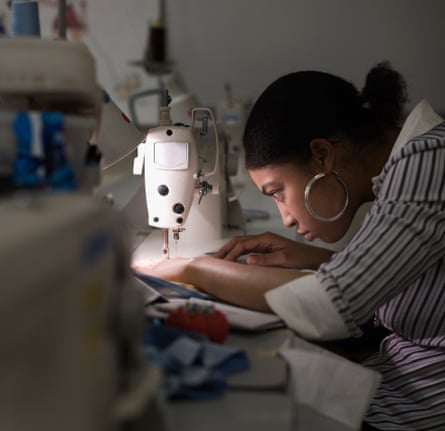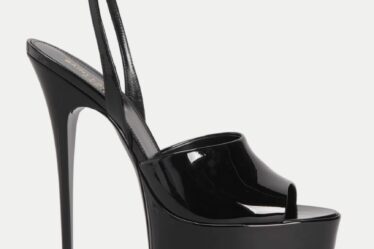
My favourite T-shirt is almost six years old. It’s a black, fitted crew neck tee that was made in Australia from Japanese cotton jersey. Not a single T-shirt I’ve bought since comes close in fit or quality.
I think it retailed for about $200, which seemed like a lot at the time (and even more given the cost of living crisis now). But I am still wearing it regularly six years later (and not in a just-around-the-house way) so on a cost-per-wear basis, it has paid for itself.
Since reducing consumption is at the heart of a sustainable fashion industry, I spend a lot of time advocating for purchases like this: buy once, buy well! Unsurprisingly, what often comes up in these conversations is price. Particularly when it comes to basic items, like T-shirts.
A recent report from the Australian Fashion Council revealed just how bad Australians are at buy once, buy well. The most terrifying statistic: on average Australians buy 56 new items of clothing a year at an average cost of $6.50 each. Which is somehow, disturbingly, less than the price of many fast-food hamburgers.
When I first saw this stat I thought it must be an error. What type of garments are sold for so little? (It’s no wonder that almost two-thirds of all the clothes we buy end up in landfill when they’re so cheap). And worse, who is being forced to make them?
As we head into sales season, it is worth thinking about the elements that go into a T-shirt, so you can compare them with the retail price.
The basics
Generally speaking, the price of a T-shirt is calculated by combining the cost of materials and the cost of labor; this figure is then multiplied to account for the overheads of running a business (usually by 2.2) and then by 2.2 again to calculate the retail price. These margins do vary depending on the business model, but this is a good rule of thumb.
Let’s start with material cost
According to Courtney Holm, the founder and designer of A.BCH, the quality and type of fabric will dictate a significant portion of a T-shirt’s price (about a third of the cost price to the brand, and a tenth of the retail price). She pays $8.63 for a T-shirt’s worth of GOTS-certified organic cotton that has been milled in Australia.
Natural fibres will generally be more expensive than synthetic blends, she says. But “100% natural fibres like cotton, linen, hemp or wool T-shirts are going to generally last longer – less pilling, less staining and stink – than blended materials (like poly/cotton or cotton spandex) and will generally represent better value for money in the longer term”.
Other things to consider are the type of threads, labels and packaging used. As well as the hand feel, “heavier weighted T-shirts will be more expensive as they require more material to make, but again they should last longer than a cheaper thin T-shirt”.
The price of labour
I think it’s useful, when contemplating the cost of labour for a T-shirt, to consider the steps involved in actually making one. Someone has to lay down a pattern and physically cut the material into the right pieces, before sitting at a sewing machine and turning them into a garment with hems and a collar. According to Holm this takes approximately 24 minutes and makes up almost half the cost price.
It is worth noting that when garments are made in large quantities the cutting can be done in bulk, saving time. And simple T-shirts might have a faster turnaround time for a highly skilled worker. But the reality is that the lower the price of the T-shirt the more likely a garment worker has been squeezed either for time or financially, although a luxury price doesn’t guarantee fair conditions for the person who made it either. While it does not cover every brand, you can get a fair idea of whether a company pays workers a living wage by looking them up in Good On You’s directory.
Where it’s made
The place where a garment was manufactured will also influence its price. Compared with south-east Asia, where the vast majority of the world’s fabric and garments are produced, the energy and labour costs of manufacturing in Australia are high.
While a Made in Australia label doesn’t necessarily guarantee best practice, local factories have to comply with Australian workplace laws and environmental standards, while proximity to design studios makes it easier to have visibility into working conditions.
Other costs to consider
According to Holm, the retail price of a T-shirt will also have to account for some of the other elements of running a fashion business, such as GST, design, shipping, marketing, retail and website costs, and profit. She says that in her business these things add up to approximately 50% of the retail price, but for other brands “sometimes the mark-up is even greater”.
If you are buying from a brand invested in running their business ethically, your T-shirt might also include costs for certifications and an aftercare or repair program. Taking into account all these elements, it’s hard to see how everyone along the supply chain of a T-shirt (from cotton farmer, to mill, to garment factory, to design team and retail store) could be treated fairly when a T-shirt costs $6.50.
“As an everyday individual who buys clothes, it can be difficult to know” the true cost of a garment, Holm says. Due to subcontracting, she says sometimes “even the brand might not know themselves, which is scary”.
A T-shirt that lasts

“Look for T-shirts that will last in quality, mid-heavy weight knits,” Holmes says. “Cost per wear is one way to calculate what it really costs you over the long term … look out for brands with aftercare programs where you might receive free or low-cost repairs, alterations or resale options to help extend the life and value of the T-shirt even further.”
Of course, not everyone can afford the upfront price of an ethically made T-shirt. Holmes’ suggestions about a T-shirt’s fabric apply “whether brand new or thrifted”. A second-hand T-shirt that is made to last will often outlive a new, lower quality top, for the same price.



